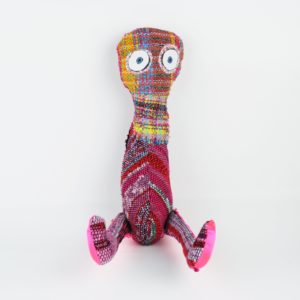Meet Juliet Martin, one of our 2018 LEAP finalists and a featured artist in The Store from April through June. Martin’s work makes the viewer see the message beyond the handwoven textiles and quirky compositions of mixed materials. By creating perilously humorous images with satirical forms and caustic visual texts, Martin shows an emotive depth through her work. She wants the viewer to laugh at what they see and then cry a little.
Read on to learn more about Martin and her artistic process. Stop by The Store to shop for her curious and quirky textile creations from wall hangings and decorative creatures to functional handwoven pouches.
 Tell us about your work.
Tell us about your work.
I make my viewers see the message beyond the joke by illustrating personal stories with satiric forms, painful punchlines, and caustic visual one-liners. I am not always funny, but I am always sincere. I apply the Japanese philosophy of Saori, which embodies a Zen mindset that encourages freeform weaving – no patterns, no rules, no mistakes.
Why fiber? Weaving fabric physically and mentally attaches me to my canvas. You?d be surprised how improvised it is. Decisions are made as the shuttle moves across the threads.
How does your background influence your work?
I studied computer art and focus mostly on web-based art pieces. Using tools intended for something functional and utilitarian can also make something “frivolous” – fine art. I was drawn to decontextualize the functional, almost subconsciously. Weaving, originally intended for practical use, doesn’t need to be worn, but can be turned into sculptures.

Why were you drawn to making art?
There was no beginning; I have always been serious about making things. When I was nine, my mom dropped my meticulously completed coloring book in the water. My life’s work, gone. I HAD to replicate the coloring book even better than before. There was no choice.
What are your inspirations?
Mike Kelley and Louise Bourgeois would be my best tea-party invitees, if I could dig them up. Their stuffed animals and giant spiders are sensitive and telling; the playfulness masks interior insecurity.
What is the best piece of advice you received as an artist?
“Do more than the maximum.” As a CD-ROM graphic designer in the mid-90s, my work was less than stellar. After I did no more than what I was told, my boss said that if I want to succeed, I had to exceed what was asked.
What advice would you give others considering a career in art?
Creativity is not a competition.
How will the LEAP Award help with your practice?
 “Is your work art or craft?” I still can?t answer this. My work can’t be worn, but fiber’s roots are in its functionality. My work is both playful and serious, crafted and theoretic.
“Is your work art or craft?” I still can?t answer this. My work can’t be worn, but fiber’s roots are in its functionality. My work is both playful and serious, crafted and theoretic.
By presenting at LEAP, I can simultaneously show my collection in the context of a gallery and a consumer market. Contemporary Craft’s supportive space allows me to be an idea-driven craftsperson and a technically driven artist. People keep telling me to exclusively pursue craft or art. Recognition by Contemporary Craft’s LEAP program strengthens my balance on the edge.

